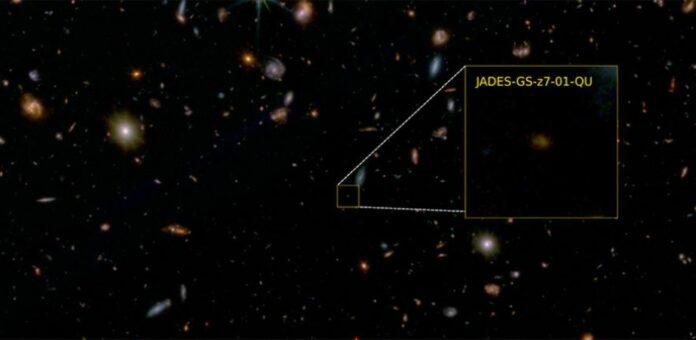An international team of astronomers led by the University of Cambridge has found a ‘dead’ galaxy using the powerful James Webb Space Telescope. This galaxy was discovered when the cosmos was only 700 million years old, making it the oldest “dead” galaxy ever seen.
This galaxy is interesting because it appears to have lived a short life and died young. Its star formation was fast, but it ended suddenly, too soon for this early in the universe’s history. Nevertheless, it remains unclear what specifically stopped the production of new stars in this galaxy and if its inactive state is temporary or permanent.
The findings shed important light on the mechanisms underlying galaxies’ inability to produce new stars and whether these parameters have altered over billions of years of cosmic history.
Astronomers have discovered numerous variables that can hinder or stop star formation in a galaxy. In essence, these elements deprive the galaxy of the gas necessary for the formation of new stars.
Internal processes that drive gas out of the galaxy and suddenly stop star formation include supermassive black holes and feedback from active star formation.
On the other hand, star formation itself can consume gas at a speedy rate without the timely replenishment of fresh gas from the galaxy’s surroundings. This situation, known as galaxy starvation, can also cause star formation to halt.
Co-author Professor Roberto Maiolino said, “We’re not sure if any of those scenarios can explain what we’ve seen with Webb. Until now, to understand the early universe, we’ve used models based on the modern universe. But now that we can see so much further back in time and observe that star formation was quenched so rapidly in this galaxy, models based on the modern universe may need to be revisited.”
The data from JADES (JWST Advanced Deep Extragalactic Survey) suggest that this galaxy experienced a short and intense period of star formation between 30 and 90 million years ago. But between 10 and 20 million years before the point in time when it was observed with Webb, star formation suddenly stopped.
In addition to being the oldest observed galaxy, this galaxy is also relatively low in mass, similar to the Small Magellanic Cloud (SMC), a dwarf galaxy near the Milky Way. However, unlike the SMC, which is still actively forming new stars, this observed galaxy appears to have stopped star formation.
In the past, other quenched galaxies in the early universe were typically much more massive. However, thanks to the improved sensitivity of the James Webb Space Telescope (Webb), astronomers can now observe and analyze smaller and fainter galaxies like this one.
Despite appearing “dead” at the time of observation, astronomers believe there’s a possibility that this galaxy may have “come back to life” over the roughly 13 billion years since its word and started forming new stars again.
Co-author Dr Francesco D’Eugenio, also from the Kavli Institute for Cosmology, said, “It could be the case that galaxies in the early universe ‘die’ and then burst back to life—we’ll need more observations to help us figure that out.”
Journal Reference:
- Looser, T.J., D’Eugenio, F., Maiolino, R., et al. A recently quenched galaxy 700 million years after the Big Bang. Nature (2024). doi: 10.1038/s41586-024-07227-0
